
The main Qantas pilot union, the Australian and International Pilots Association (AIPA), has issued a rare, detailed critique of the airline’s management over Australia’s pilot shortage as more employees quit for roles across the United States, Middle East and Asia.
The problem — and its pressure on wages and conditions — is looming as a key test for Qantas CEO Vanessa Hudson, only six months into her role, and her inherited industrial relations strategy.
“The challenge is can those leading the Qantas Group recognise the pilot labour challenges before them and decide that genuine reform of the industrial landscape is needed. Reform to safeguard the asset that is their pilot community. Do they seek band-aid solutions to stem the bleeding, or do they recognise the value of actually healing the wound?” AIPA said in a March 21 email to its members.
“Qantas needs to discard previous industrial ideology to ensure this country has enough pilots to meet projected demand and to protect these assets, including you, from looking overseas for better opportunities, no matter what stage of your career.”
Diminishing returns
The AIPA critique follows recent comments by the Australian Federation of Airline Pilots, which remains locked in a bitter industrial dispute with Qantas Group over pilots wages and conditions at Network Aviation, its Perth-based regional subsidiary. Mediation ends Thursday, and if there is no agreement the Fair Work Commission will draw up an enterprise bargaining agreement. Qantas has begun talks with unions on an EBA for short-haul pilots that expires in June.
Regarding the shortage of pilots in Australia, AIPA noted the complexity of factors contributing to the issue. However, one driving factor has been “the driving down of wages through the creation of various subsidiaries”, which, when coupled with the “ever-increasing costs of obtaining flying qualifications — now in the vicinity of $150,000”, has diminished the profession’s appeal to recruits.
The problem for the Australian aviation sector is supply and demand, exacerbated by the pilot shortage extending globally, with the US forecasted to need more than 130,000 over the next two decades. Australian pilots are uniquely positioned for jobs in the US thanks to the E-3 visa as part of the Australia-US free-trade agreement, inked in 2015. Between then and March 2023, 3,793 Australian pilots have been granted an E-3 visa.
‘You can mix it up’
Speaking to Crikey, two pilots who recently left Australia for employment with US airlines cited a lack of career progression, a broader array of professional challenges, more take-home pay, more time at home, and more opportunity for travel as motivations for their career shift. Due to their contractual obligations, the pilots cannot be named.
“Whether an Aussie is flying in the US as an airline pilot or cargo pilot, one thing remains constant across the industry: the choice of flying more to make more, or flying less to spend more time with the family. That degree of flexibility is impossible currently in Australia,” said one pilot.
Pay aside, the pilots remarked that another significant difference is the flexibility to change work patterns.
“On your fleet, you can bid month to month for more work, or more days off, or to fly a line, or sit reserve. You can change your fleet and seat every two years if you choose, largely without limitation, so if your current type of flying gets stale, you can mix it up.”
Indeed, one of the key reasons Jetstar, owned by Qantas, is struggling to find pilots for its main base in Sydney is the time-consuming, costly commute, where parking involves a bus to the terminal and eye-watering road tolls, pilot sources told Crikey.
“The US offers incredible flexibility in your choice of which direction you would like your career to progress. Within a legacy airline with multiple fleets, you can change your flying position every two years, allowing for new professional challenges, more earning potential, or more time at home,” one pilot said.
The consensus between offshore pilots, Australian pilots, and pilot unions in Australia is the same. The danger of Australia losing more recruits — and Qantas’ current industrial dispute is only exacerbating the problem — comes down to the airlines themselves.
“Whether those in leadership positions within the company [Qantas] see the value in safeguarding their pilots rather than parking aircraft against a fence is for them to decide. But they can’t say they didn’t know or weren’t warned,” AIPA said.







